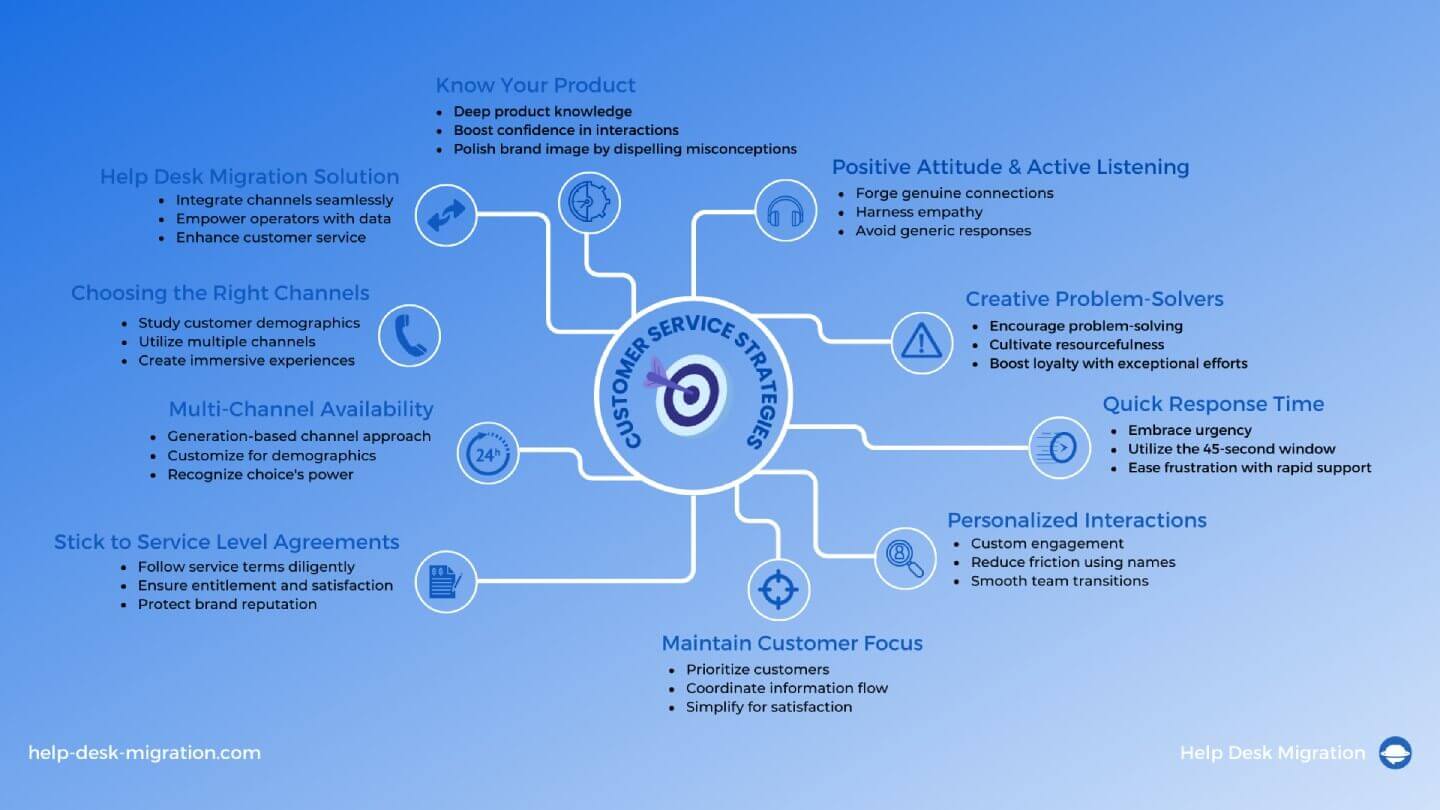Good customer service has the potential to double a company’s revenue. However, many businesses still often downplay its importance. What’s more, many are still confused about what constitutes good customer service and how to make their customer support more efficient. Whether you are among the former or the latter, this article is for you!
Here we’ve collected useful facts and recommendations to map your way toward increasing your profit through better service.
Why Companies Should Value Customer Service
Good customer service can benefit your business in more than one way. It can improve customer retention, encourage repeat purchases and positive word of mouth, and even generate valuable business ideas.
Customer retention
Keeping a customer around typically costs 5 to 7 times less than attracting a new one. It can literally take just a single positive interaction with your customer support service: 82% of customers who had this experience were likely to stay with the same company even when presented with a better offer from a competitor.
Yes, the person reaching out to the support team has already experienced a problem with your product. However, even in this situation, most people are willing to give you a second chance. At least 67% of departing users would’ve stayed with the company if their problem had been resolved in the first interaction. In other words, good customer service can help you retain customers and turn their initial disappointment into a positive experience.
Brand reputation
In the age of social media, word of mouth can either bring your business to new heights or ruin it. 36% of disgruntled customers will actively share their sentiments with friends and colleagues, while 18% will post a negative review.
Online reviews are carefully considered by the majority of shoppers. 94% of people are deterred from buying by negative feedback. That means that a single failing interaction might cost you more customers than you’ll ever know — not just the ones who walked away but also anyone they told about the experience.
Revenue growth
A superior customer experience can increase sales revenue by 2-7%. Companies providing better service have been found to grow their revenue twice as quickly as the rest of the market.
Customer satisfaction is indirectly converted into new purchases through improved retention and better reviews. However, it can also directly generate new sales. 91% of people will consider making a repeat purchase after a positive customer support experience. 86% are prompted to spend more money on their next purchase. This means that service quality can be a highly reliable investment with a short period of return.
Strategic insights
An overlooked benefit of good customer service is its ability to fuel experience-led growth. When you take a proactive approach and ask your customers what they’d like to see improved, you may get valuable insights that no conventional market research would provide.
Using the ideas from customer feedback, one American company reduced its churn rate by 75% and nearly doubled its revenue over the next three years. All they had to do was ask their customers and listen to them. Thus, service excellence can help you craft a more viable business strategy and get ahead of the competition.
TLDR;
| Benefits of good customer service | Explain in detail |
| Customer Retention | Keeping a customer costs 5-7 times less than acquiring a new one. Positive customer support interactions lead to higher retention rates. 82% of customers with a positive support experience are likely to stay with the company, even when offered a better deal by a competitor. 67% of departing customers would have stayed if their problem was resolved in the first interaction, showcasing the value of effective customer service. |
| Brand Reputation | Word of mouth can greatly impact business success. Negative sentiments shared by 36% of unhappy customers and 18% posting negative reviews can harm brand reputation. 94% of shoppers are influenced by negative online reviews, potentially deterring them from making purchases. |
| Revenue Growth | A superior customer experience can boost sales revenue by 2-7%. Companies with better service grow revenue twice as fast as their competitors. Positive customer support experiences lead to repeat purchases (91% consider) and increased spending (86% spend more) on subsequent purchases. |
| Strategic Insights | Good customer service can provide valuable insights for experience-led growth. Proactively seeking customer feedback can lead to innovative business strategies. One example saw a 75% churn rate reduction and doubled revenue over three years by utilizing customer feedback for improvements. |
What Does It Mean to Provide Good Customer Service
Different people might have different ideas of what good customer service is, yet there are certain patterns. The common factors cited by customers include timely resolution of their problem, the agent’s knowledge and resourcefulness, and not having to explain the issue over and over again.
68% of customers expect brands to demonstrate empathy. It’s most important for Gen Z members: many of them place a higher value on empathy than on timely resolution.
Another area for improvement is personalization. 62% of customers would like their experience with support services to be more personalized.
Providing the service of help desk migration, we often receive positive comments about our customer support quality. It’s not easy to identify customer needs with this kind of service, so we asked our support team about what good customer service means for them. Here’s what they said:
Good customer service is the ability to understand customer needs and requirements (even if you don’t have a total picture of the whole process) and to meet desired expectations in close terms.
Good customer service is being knowledgeable and empathetic, providing effective solutions, thinking out of the box, communicating clearly, and personalizing interactions. Customer service requires a lot of effort and patience. Last but not least, excellent customer service is about continuous improvement.
Good customer service, to me, is providing prompt and helpful responses to customer inquiries, being empathetic and understanding towards their needs. It's about treating customers in a respectful, professional, and personal way while delivering a positive experience.
Based on these surveys and comments, we pointed out a few core elements of excellent customer service. Let’s take a closer look at them below.
What Are the Elements of Good Customer Service
To provide good customer service, your support team needs to check all of the following boxes:
Know your product
When the person on the line is not aware of essential aspects of your product or gets them wrong, your whole company will look unprofessional.
Have a positive attitude and practice active listening
Customers want to feel that they’re talking to a living person who cares. They dislike responses that feel overly formal and robotic.
Be creative problem-solvers
A solution to a customer’s problem is not always straightforward. Encourage your staff to do their best to help. Even if the effort eventually fails, the customer will appreciate them going the extra mile.
Respond quickly
Most people will wait for a reply in a support chat for no more than 45 seconds. Without a prompt response, they will assume no one is going to solve their problem.
Personalize interactions
In an age when people are used to seeing their names even on automated emails, there’s absolutely no excuse for addressing them by number. What’s more, when transferred to another support staff member, the customer will expect that they’ve already been filled in on the situation. Nothing annoys customers more than having to explain their problem again.
Maintain customer focus
It’s the customer and their problem that matter. If the customer has to switch between multiple communication channels to get it solved, make sure that the information is shared across the channels so they can skip repeat explanations.
Stick to your service level agreements
It should go without saying, but there are still cases when support staff lacks knowledge of service agreement terms and denies customers things they’re entitled to, such as replacing an item covered by warranty.
Be available where the customer is looking for you
Customer support can be provided in a variety of communication channels. The need to maintain multiple channels at the same time was confirmed by a recent customer survey. It found different channels to be preferred by different categories of customers, such as:
- Phone. This channel is still popular with older people. For over half of Baby Boomers, nothing beats a good old phone call.
- Messaging apps. This channel is favored by Millennials: about one-third of them would rather message you on Viber or WhatsApp.
- Social media. Gen Z customers are most likely to reach out to companies on social media.
- Email. Despite all the claims about this support channel being slow, clumsy, and outdated, it’s actually loved by the youngest customers. About 50% of Gen Z members would look for your email address first.
A few other popular support channels are:
- Live chats. This channel can be highly effective for urgent requests that have to be solved in real-time. However, make sure that the chat is properly staffed!
- Website contact forms. While not in high demand with customers, a website form is extremely easy to put in place and maintain, so many businesses prefer to have it just in case.
Since customer preferences for support channels can vary considerably, your choice will depend on what audience you’re targeting. However, it’s better to have several adequately staffed channels than rely on only a single one. With the Help Desk Migration solution, you can easily transfer your data to a product that integrates several channels. As a result, operators will be able to share information easily and provide great customer service.
The task of providing good customer service might seem daunting, but it is not impossible. There are inspiring examples of real-world companies that have managed it.

Challenges of Good Customer Service
Your support team faces numerous challenges daily as they work to deliver great customer service. Some are easy to tackle, while others are more complex. But how to provide good customer service if your team faces these challenges?
Serving multiple customers at a time
When customer support gets busy, agents may juggle multiple inquiries, impacting individual attention. This might happen due to seasonal or daily peak hours, staffing issues, or unexpected circumstances. As a result, customers can feel neglected or have a negative experience.
Facing frustrated customers
Dealing with upset customers is tough, but staying calm and understanding their concerns can help. Apologize for any inconvenience, assure them their concerns matter, and thank them for bringing the issue to your attention.
Not meeting customer expectations
Customers expect quick and efficient service, but agents may fall short due to a lack of skills, knowledge, or meeting service standards. In some cases, customers feel their problems aren’t getting enough attention. Identifying and addressing these gaps is key to enhancing good customer service.
Not having the right tools
Good customer service is crucial, but it becomes challenging without the right tools. Agents need easy access to customer data, product knowledge, and efficient communication channels.
Without these tools, customer frustration may rise, leading to dissatisfaction and potential loss to competitors. To address this, assess agent workflows, identify bottlenecks, and introduce or remove tools.
Real-Life Examples of Good Customer Service
These companies will be remembered for life by the customers they’ve helped — and by millions of those who have read the story on the web.
Zappos
Zappos is a footwear company known for its excellent customer service and one of the friendliest return policies. They don’t even demand that defective products be returned; they will ship a replacement to the customer overnight, at their own cost.
Trader Joe’s
Trader Joe’s remains the only major grocery chain in the US that does no online deliveries. However, when an 89-year-old man was snowed in by a storm, they delivered all the groceries he needed at no charge.
LEGO
A young boy lost a LEGO mini-figure he had saved up to buy. He wrote a heartfelt letter to LEGO explaining his situation. The customer service team not only sent him the missing mini-figure but also included some extra figures and a personalized note, delighting the young customer and his family.
Ritz-Carlton
The Ritz-Carlton hotel chain is famous for its great customer service. One instance involved a family staying at a Ritz-Carlton property whose child left behind a stuffed animal. The hotel staff not only found the toy but also documented its "extended stay" with photos of the stuffed animal lounging by the pool and receiving spa treatments, which they shared with the family. This thoughtful gesture left a lasting impression.
Southwest Airlines
A desperate bridesmaid turned to Southwest Airlines to deliver the dress she’d forgotten in Texas to Costa Rica where the wedding was to take place. The support team accommodated this request, unusual as it was, and the dress arrived just in time to save the day. Several departments across Southwest Airlines worked together to arrange the delivery, highlighting the importance of teamwork and coordination for good customer service.
These stories demonstrate the power of personalized and thoughtful gestures in great customer service. Going above and beyond to surprise and delight customers can create lasting positive impressions and foster strong customer loyalty.
How to Improve Your Customer Service
Realizing that your customer service is falling short of perfect, you’ll probably be wondering how you can improve it. Here are several tips for good customer service to begin with.
Be proactive
Great customer service is about being proactive. Set up an easy support center and detailed FAQs on your website. This way, customers can find answers themselves. If they need help, a real person is just a few clicks away!
Collect customer data
The more you know about this particular customer, their needs and experiences with your product, the more context-based support you will be able to deliver. Most customers appreciate it when the company remembers their preferences and their history of requests; they view it as a sign that you care about them.
Get feedback
Gathering feedback is an effective way to uncover your strengths and weaknesses and pave the way for the best customer service. Let your support reps and customers share their thoughts via surveys or focus groups. Here’s the secret: keep it anonymous for honest, no-holds-barred insights. Then, use all the feedback to deliver great customer service.
Analyze your customer journey and adjust your processes to match it
Ask yourself, at what stage of using your product is the customer most likely to experience a problem? What means of communication will they have close at hand at that moment? If your product is a mobile app, you will likely receive the majority of help requests through a built-in chat or via messengers.
Invest in your team
Happy employees provide better customer service. They also need to be properly trained to know the product thoroughly and be able to help. The selection process should focus on choosing candidates who have the soft skills and the right mindset, and who take genuine pleasure in helping others.
Invest in a help desk system
Help desks, also known as ticketing systems, are software solutions designed for customer support teams to easily collect, store, and manage customer requests. Some of the most popular help desk platforms are Zendesk, Jira, and Help Scout.
As of 2022, only 50% of companies worldwide have employed help desks. However, all the highest-growth companies have taken this step.
If your current help desk is falling short of your demands, you can use our Help Desk Migration to easily move to a more advanced one, without losing your data.
What Is Good Customer Service
Evolving customer expectations are constantly raising the bar of what counts as good customer service. If you’re having trouble promptly addressing support requests, you may be in need of more efficient, up-to-date customer service software. If you are looking to import your support service data to a new help desk, we can help you solve this problem while preserving all your workflows intact. Start a free Demo or request a personalized Demo with our support reps.
Frequently Asked Questions
Good customer service involves understanding and meeting customer needs and expectations promptly and effectively. It requires clear communication, empathy, problem-solving, and a willingness to go above and beyond to ensure customer satisfaction.
Customer service skills are the abilities and traits that enable individuals to effectively interact with customers. These skills include active listening, empathy, communication, problem-solving, patience, and adaptability.
A good service desk is a well-organized and efficient support system that handles customer inquiries, issues, and requests. It provides timely and effective solutions, has knowledgeable staff, utilizes technology effectively, and strives to improve customer experience.
Customer service focuses on assisting and satisfying customers with their general inquiries, concerns, and needs related to a product or service. A help desk, on the other hand, specifically deals with technical support and troubleshooting, providing assistance to resolve technical issues customers may encounter.
The main function of a help desk is to provide technical support and assistance to customers, often related to IT products, software, or systems. It aims to resolve technical issues, answer questions, and ensure smooth functioning of the technology.
- Enhance communication by actively listening to customers and providing clear and concise responses.
- Train staff to handle diverse customer situations, fostering empathy and problem-solving skills.
- Streamline processes to ensure quicker response times and efficient issue resolution.
- Prompt responsiveness to customer inquiries and issues.
- Personalized interactions that make customers feel valued.
- Effective problem-solving and resolution of customer concerns.
- Consistent and ongoing efforts to improve the customer experience.
- Listen actively to understand their concerns fully.
- Communicate clearly and empathetically, assuring them that you're there to help.
- Analyze the issue and provide accurate information or solutions.
- Ensure follow-up to confirm that the issue has been resolved to their satisfaction.





